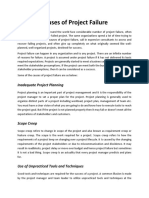Project Mismanagement: Eight To Late: International Journal of Computing and Corporate Research IJCCR India
Project Mismanagement: Eight To Late: International Journal of Computing and Corporate Research IJCCR India
Uploaded by
admin2146Copyright:
Available Formats
Project Mismanagement: Eight To Late: International Journal of Computing and Corporate Research IJCCR India
Project Mismanagement: Eight To Late: International Journal of Computing and Corporate Research IJCCR India
Uploaded by
admin2146Original Title
Copyright
Available Formats
Share this document
Did you find this document useful?
Is this content inappropriate?
Copyright:
Available Formats
Project Mismanagement: Eight To Late: International Journal of Computing and Corporate Research IJCCR India
Project Mismanagement: Eight To Late: International Journal of Computing and Corporate Research IJCCR India
Uploaded by
admin2146Copyright:
Available Formats
International Journal of Computing and Corporate Research IJCCR India PROJECT MISMANAGEMENT: EIGHT TO LATE
Prof.S.S.Kapase , Prof.S. P. Shinde, Prof.V.P.Deshmukh
1
Department of Computers, Bharati Vidyapeeth University, Institute of Management and Information Technology, Navi Mumbai, Maharashtra, India
2
Department of Computers, Bharati Vidyapeeth University, Yashwantrao Mohite Institute of Management Karad, Maharashtra, India
Department of Management, Bharati Vidyapeeth University, Yashwantrao Mohite Institute of Management Karad, Maharashtra, India
ABSTRACT Projects turn corporate strategy into reality, and in a sense, everything an IT manager does, takes the form of a project. Yet, the concept of managing projects is poorly understood and executed. There is no doubt that many companies do a lousy job of prioritizing and allocating project resources. Worse, they fail to effectively implement the hard-won strategies. Researches continually show that companies have difficulty with information technology (IT) projects to complete on time or on budget. In fact many are cancelled before completion or not implemented. The most common causes for IT failures are related to project management. Its true that every project is unique. However, it's also true that all project failures can be assessed using the same generalities. Understanding them can help
you be proactive. The results of mismanagement can be devastating, with projects missing key deadlines, exceeding budgets, and failing to meet business goals. The paper explores the reasons for project failures encountered by organizations and how to avoid these failures. Keywords: Project, Scope Creep,
Mismanagement, Cripple.
INTRODUCTION Project management encompasses all activities, right from receiving the proposal from the customer to delivering the product and warranty maintenance. These activities are categorized into different stages in the software life cycle development. Naturally the name itself implies that it happens during the development stages of the project. It is normally mistaken that if the plan is good, everything
should go smoothly from then on. Actually it is not so, execution of any project is as important and challenging as the planning. Project Mismanagement happens if there is inadequate monitoring and control at every stage of development, even though utmost care has been taken to bring out a good project plan at the initial stage. WHY PROJECT MANAGEMENT IS IMPORTANT? Project management has emerged as a crucial factor that determines the success of an WHAT IS PROJECT MANAGEMENT? Project management is a carefully planned and organized effort to accomplish a specific (and usually) one-time objective, for example, organization. Whether it is a question of facing an economic crisis or generating large
turnover, project management plays a pivotal role in the growth of a firm. Companies recruit project managers that lead the team in order to timely achieve the targets set by the clients and customers. In management terminology, the duration in which an entire project is carried out, from its inception till the end, is called the project life cycle. The project life cycle can consist of one or multiple project management approaches. The management approaches are the various project management
construct a building or implement a major new computer system. Project management includes developing a project plan, which includes defining and confirming the project goals and objectives, identifying tasks and how goals will be achieved, quantifying the resources needed, and determining budgets and timelines for completion. It also includes managing the implementation of the project plan, along with operating regular 'controls' to ensure that there is accurate and objective information on
methodologies that the team can decide to follow so that the target is achieved in allotted time. What are the various management
'performance' relative to the plan, and the mechanisms to implement recovery actions where necessary. Projects usually follow major phases or stages, including feasibility,
approaches? The most basic analysis of the project is called as the initiation stage of a project. After this stage, designing or planning is done to streamline the task and make a flexible strategy to complete the task. Then the execution phase takes the center stage, and in
definition, project planning, implementation, evaluation and support/maintenance etc.
this phase, the project is practically tackled with all its pros and cons. The monitoring and controlling of the project is done with the execution stage to check the possible threats and keep an eye on the performance of the team. Once the project is about to finish, it goes into the closing phase, where all the activities are finalized. Some of the prime advantages of having a good project management team for a company are as follows.
Lack of executive support and user involvement Failure to communicate and act as a team Inappropriate skills
Poor Testing
Excellent product quality
Adequate communication
Reducing risks
Strategic objectives and goals.
Poor planning:Sometimes IT managers are not given the opportunity to plan because time pressure from senior management take over and most of the time the project is on its way before it has been
FACTORS FOR PROJECT MISMANAGEMENT
The most common causes for IT failures are related to project management. The following list the primary causes for the failure of complex IT projects:
clearly. In such cases, people see planning as a waste of time because they believe that time is better spent doing something rather than planning Most projects have major milestones, and the problem is that the work continues throughout each milestone implementing
Poor planning Unclear goals and objectives Objectives changing during the project Unrealistic time or resource estimates
sometimes starts before plan completion and continues through most of the testing.
IT projects are full of start to finish relationship. Many activities can only start once another activity is completed and approved. The critical path is important, because any deviation from the schedule in this path could cause entire project failure. Detailed plans are not effective for managing IT work. The reason is that the managers do not know enough about the work to make detailed plans .Team members might make their own plan but most of them do not want to. They would rather implement the solution. Few of them have the skills and experience to make complete plans, and there is a big risk in trusting them in producing their own plans that will meet management
Feature creep.
Scope
creep
refers
to
uncontrolled
and
unexpected changes in user expectations and requirements as a project progress, while feature creep refers to uncontrolled addition of features to a system with a wrong assumption that one small feature will add nothing to cost or schedule Unrealistic time or resource estimate:Estimation mistakes of time or resource cause project related problems. One common problem during the creation of the Work Breakdown Structure is assuming that the time on task equals duration. The time on task is the time the task will take to complete without interruptions, whereas
objectives. Unclear goals and objectives:Sometimes the goal of a project may be only partially clear due to a poor requirement gathering in the definition stage of a project. Defining clear requirements for a project can take time and lots of communication, but sometimes goals and objectives might be unclear because project sponsors lack the experience to describe what they really. Objective Changes during project:Many project managers had the feeling that their IT project would never stop growing. IT projects suffer from two classical problems in project management:
duration is the time the task actually take to complete including interruptions. Using the time on task to estimate schedule is one of the common mistakes made by project. Linear thinking supports the conclusion that increasing the people by 100 percent would decrease the schedule and increase the cost to approximately the same degree. In reality, doubling the staff produce a non-linear result Lack of executive support and user
involvement:The research companies and academic
institution has focused on the lack of executive support and user involvement as two main
Scope creep
difficulties in managing IT projects .The project
manager is the interface between the business and technology sides of the company .Without executive support project managers in the organization find difficulty in aligning business with their projects. The executive management also needs to be straightforward if they have reservations about the project. Otherwise, once problems are encountered in the project their support will weaken. Most IT projects will change the work life of many users and require that they participate in design and implementation. Without user
Inappropriate skills:The challenge of global competition, the rapid growth of knowledge, and the constant changes of technology make it hard to predict what kind of skilled people will be needed. Most IT projects require a diverse range of skills. Many teams lack the breadth, and depth they require. It is also not easy for technology based organization to find the experienced people they need because sometimes few people in the labour market have the necessary skills. The larger the project, the more need there is also for people with excellent planning, oversight, organization, and communications skills; experienced technology skilled people do not necessarily have these abilities. Poor Testing:The developers will do a great deal
involvement nobody in the organization feels committed to the project. User involvement requires time and effort, but the staff might be already stretched and unable to find time for a new project on their schedule. That is why executive management support is important to make priority clear to the staff. Failure to communicate and act as a team:Projects sometimes fail due to improper communication. Communication problems are common on large IT projects. Because complex IT projects often involve large amount of analysis and work, the project teams are busy and the executive management sees no progress. IT project managers do not communicate progress regularly because they believe that progress will not be seen by the executive management. In many IT projects, there is no one person who has an overview of the whole project.
of testing during development, but eventually the users must run acceptance tests to see if the system meets the business requirements. However acceptance testing often fails to catch many faults before a system goes live because:
Poor requirements which cannot be tested.
Poorly or non planned tests meaning that the system is not methodically checked.
Inadequately trained users who do not know what the purpose of testing?
Inadequate time to perform tests as the project is late.
Users, in order to build their confidence with a system, and to utilize their experience of the business, should do the acceptance testing. To do so they need good testable requirements, well designed and planned tests, be adequately trained, and have sufficient time to achieve the testing objectives. AVOIDANCE OF THESE FAILURES Perform a detail plan before the start of the project.Review and adjust plan on a daily basis. The plans created during this phase will help you to manage time, cost, quality, change, risk and issues. They will also help you manage staff and external suppliers, to ensure that you deliver the project on time and within budget. Goals and objectives are statements that describe what the project will
the project can be placed in the proper context. The Project objectives change can be avoided by only modify products if business critical ,Testing the change in scope against the business case,
Evaluating impact on cost, schedule, and risks, implementing scope changes in the next release & setting up a Change Management committee. Not having the right amount of resource or indeed having the right amount with the wrong skill mix can be a cause of project failure. Insist that management provide suitable resources either from internal staff or if necessary by hiring contract staff. Successful projects need input from the people who will be affected most by the project. The users should be consulted on the value they will receive from a product. They better understand the business processes and how to improve efficiencies than anyone else on a project team. These users can best help with process improvements, features, and functions. Another key factor on user involvement is who will be included on the team. Successful projects have the best and brightest users on the team. These individuals make the best
accomplish, or the business value the project will achieve. Goals are high level statements that provide overall context for what the project is trying to achieve, and should align to business goals. Objectives are lower level
statements that describe the specific, tangible products and deliverables that the project will deliver. Make sure that there is an understanding on both sides of the broader goals and aspirations of each organization, so that
decisions in a timelier manner. Communicate Openly With the Team:
Successful project manager must possess strong listening skills, must be able to show empathy, and must be able to bestow recognition and praise on project team members. Issues crop up
testing, volume testing, and stress testing to test scalability. CONCLUSION The past failure need not discourage project managers from future efforts. Past examples of IT project failures gives us the opportunity to point to the relevant lessons that can be derived from recognizing areas where IT projects is more likely to fail. Project managers can position themselves to reduce the possibility for project failure by considering the following recommendations:
continuously throughout a project life cycle and can change the product scope, the schedule, and the cost, and can seriously impact the success or failure of the project. The project manager must be an active listener to anyone who
verbalizes concerns. This will not only ensure the respect of the team, but will also provide early warning of problems that may lie ahead. While listening and communicating with others, the project manager should show
Make sure to plan before starting the development or implementation.
Pay attention to tasks in the critical path. Set up the necessary processes to calculate and inform the risk.
empathy for what that individual or group is going through. It is important that the project manager understands the total environment and be able to restate that concern back to individual team members so they know that their concerns are being taken into
Ensure that the IT project has clear objectives. Understand project trade-offs when making decisions regarding objectives change. Use the duration instead of the time on task to estimate schedule.
consideration. Limiting your testing of a solution will increase the chance of system failure or unknown bugs that can cripple your business. Do not skimp on testing to save time or money. Eliminate features first. To limit project failure, the testing phase should consist of system test, customer acceptance
Avoid using linear approximation when estimating time or resources. Get the support from the executive management and ask them to be open if they have any reservations about the project. Ensure and communicate regular about the progress, even if it seems invisible.
Require that users participate in design and implementation of your project
Make sure you have the appropriate planning, communication, and technology skills.
These recommendations, along with solid project management, can reduce the risk that an IT project fails. REFERENCES [1]http://www.kidasa.com/information/articles/g oals/index.html [2]http://managementhelp.org/plan_dec/project/ project.htm [3]http://www.mariosalexandrou.com/definition /project-objective.asp [4]http://articles.techrepublic.com.com/510010878_11-5839938.html, pp. 6174.
[5]
Software Project Management by Bob Hughes and Mike Cotterell.
You might also like
- Dueñas General Comprehensive High School 1 Learning Action Cell (LAC) Session Minutes of The MeetingDocument12 pagesDueñas General Comprehensive High School 1 Learning Action Cell (LAC) Session Minutes of The MeetingLawrence Mae Asong Pamotillo II100% (13)
- PASSMEDICINE MCQs-PALLIATIVE CAREDocument22 pagesPASSMEDICINE MCQs-PALLIATIVE CAREImran Chaudhry100% (3)
- Project Management NotesDocument45 pagesProject Management NotesChetna100% (1)
- Basic Overview of Various Aspects of An IT ProjectDocument65 pagesBasic Overview of Various Aspects of An IT ProjectAbhijit Khare0% (1)
- Project Management ConceptDocument154 pagesProject Management ConceptMateri Belajar100% (1)
- Chapter 7-Project Initiation & PlanningDocument19 pagesChapter 7-Project Initiation & PlanningJaya Mohit100% (2)
- LPM 208 Information Tech.Document91 pagesLPM 208 Information Tech.agukos augustusNo ratings yet
- Unit3project MGTDocument11 pagesUnit3project MGTShivangi MishraNo ratings yet
- Om&tqm ReportDocument7 pagesOm&tqm ReportTABLAC, Abegail AgpaloNo ratings yet
- Project Formulation and Appraisal PDFDocument12 pagesProject Formulation and Appraisal PDFUpadesh Shrestha100% (2)
- Operation ManagementDocument6 pagesOperation Managementsafaa.sadek222No ratings yet
- Ans.2 (B) 2017.3 (A) Ans.3 (A) : 1. Clear Project RequirementsDocument7 pagesAns.2 (B) 2017.3 (A) Ans.3 (A) : 1. Clear Project Requirementsbajoy41714No ratings yet
- 10 Keys For Project SucessDocument8 pages10 Keys For Project Sucesssrinivas_polisettiNo ratings yet
- Name: Gwagsi Glenn FofeyinDocument3 pagesName: Gwagsi Glenn FofeyinGwagsiGlennNo ratings yet
- UNIT 5 - Software Project Management ConceptsDocument8 pagesUNIT 5 - Software Project Management ConceptsJames DinoyNo ratings yet
- Project Success or FailureDocument3 pagesProject Success or Failurebugme22No ratings yet
- 10 Key Steps WPDocument7 pages10 Key Steps WPSayantan BanerjeeNo ratings yet
- Term Paper of Project Management.Document38 pagesTerm Paper of Project Management.anuajn60% (10)
- Synopsis: Mr. Sudhanshu Parkash TiwriDocument17 pagesSynopsis: Mr. Sudhanshu Parkash Tiwriਰਣਜੀਤ ਢਿੱਲੋਂNo ratings yet
- SPM1Document9 pagesSPM1VaibhavNo ratings yet
- Final ExaminationDocument11 pagesFinal ExaminationVanessa AsyaoNo ratings yet
- Management Week 1 2Document7 pagesManagement Week 1 2Jhansen Feliciano /JHAZPRINT/100% (1)
- Presentation1 MCA I 2018Document52 pagesPresentation1 MCA I 2018Dora MaitraNo ratings yet
- 01-What Is IT Project ManagementDocument6 pages01-What Is IT Project ManagementIzhar MazariNo ratings yet
- Project Formulation and Appraisalpdf PDFDocument12 pagesProject Formulation and Appraisalpdf PDFabhijeet varadeNo ratings yet
- VBNet Thery Ass 1Document24 pagesVBNet Thery Ass 1NdumisoSitholeNo ratings yet
- ITPM Chapter OneDocument14 pagesITPM Chapter OnegideyNo ratings yet
- Unit-1, SPMDocument24 pagesUnit-1, SPMAkshay DwivediNo ratings yet
- Chapter 4 Written Discussion QuestionsDocument2 pagesChapter 4 Written Discussion QuestionsMatthew Beckwith89% (9)
- IT Project Management 2Document81 pagesIT Project Management 2Information TechnologyNo ratings yet
- Notes PM - 1. Introduction: Project Management Is The Art of Managing All The Aspects ofDocument17 pagesNotes PM - 1. Introduction: Project Management Is The Art of Managing All The Aspects ofParas SindhwaniNo ratings yet
- 10 PM Mistakes Ebook PDFDocument13 pages10 PM Mistakes Ebook PDFLakshmi ReddyNo ratings yet
- Module 8Document12 pagesModule 8isabel payupayNo ratings yet
- Planning of Particular Projects - RSW No. 5Document89 pagesPlanning of Particular Projects - RSW No. 5DaNica Tomboc JavierNo ratings yet
- Christi Griffin CIS 517Document7 pagesChristi Griffin CIS 517Suraj ManikNo ratings yet
- Project Management.Document36 pagesProject Management.OjullaIsaacNo ratings yet
- Causes of Project FailureDocument4 pagesCauses of Project FailureShaikh BilalNo ratings yet
- PM Unit 1 Q & ADocument17 pagesPM Unit 1 Q & APriya Guna100% (1)
- PM VasquezDM A1Document7 pagesPM VasquezDM A1Djoanna Marie Tee VasquezNo ratings yet
- Project Management 1Document84 pagesProject Management 1nithinnick66No ratings yet
- What Is Project Management?Document9 pagesWhat Is Project Management?jitmanna3616No ratings yet
- Assignment No.6 Project ManagementDocument6 pagesAssignment No.6 Project ManagementPatricia CruzNo ratings yet
- Research MethodologyDocument5 pagesResearch MethodologyAkanksha PendharkarNo ratings yet
- Revised JG-CECIB-Project Planning 13.4.23Document275 pagesRevised JG-CECIB-Project Planning 13.4.23Riya GupteNo ratings yet
- Chapter 1 Introduction To IT Project ManagementDocument8 pagesChapter 1 Introduction To IT Project ManagementHussen MossaNo ratings yet
- Business Management and Application For ArchitectuDocument3 pagesBusiness Management and Application For ArchitectuNamhie LongosNo ratings yet
- 5 Phases of Project ManagementDocument37 pages5 Phases of Project Managementsunshine777100% (2)
- Chapter 5Document10 pagesChapter 5hassan IQNo ratings yet
- Unit 1: Introduction To Software Project ManagementDocument36 pagesUnit 1: Introduction To Software Project Managementpranita ingaleNo ratings yet
- Project Management EssentialsDocument30 pagesProject Management EssentialsAugusto RodriguezNo ratings yet
- Notes Chapter No 1Document5 pagesNotes Chapter No 1Ashish KhadakhadeNo ratings yet
- SAD Chapter 2Document13 pagesSAD Chapter 2adicosheboNo ratings yet
- Software Project Management: Telone Centre For LearningDocument28 pagesSoftware Project Management: Telone Centre For LearningTamuka Tavonga MugombaNo ratings yet
- Project ManagementDocument74 pagesProject Managementباسمي العشقNo ratings yet
- CS042 Unit I Introduction and Software PlanningDocument25 pagesCS042 Unit I Introduction and Software Planningpawanipec2010No ratings yet
- Software Eng Lesson 7Document6 pagesSoftware Eng Lesson 7Joan KuriaNo ratings yet
- Introduction To Project ManagementDocument41 pagesIntroduction To Project ManagementBeta NoranitaNo ratings yet
- Project ManagementDocument66 pagesProject ManagementWaseemNo ratings yet
- SPM Chapter 4Document43 pagesSPM Chapter 4Ndoba HakimNo ratings yet
- 1st Assignment of P.MDocument41 pages1st Assignment of P.Masim_mbaNo ratings yet
- International Journal of Computing and Corporate Research IJCCR IndiaDocument13 pagesInternational Journal of Computing and Corporate Research IJCCR Indiaadmin2146No ratings yet
- International Journal of Computing and Corporate Research IJCCR IndiaDocument20 pagesInternational Journal of Computing and Corporate Research IJCCR Indiaadmin2146No ratings yet
- Balance Sheet of The Next Millennium - Perspective, Possibilities and ProblemsDocument7 pagesBalance Sheet of The Next Millennium - Perspective, Possibilities and Problemsadmin2146No ratings yet
- A Common Fixed Point Theorems in 2-Metric Spaces Satisfying Integral Type Implicit RelationDocument12 pagesA Common Fixed Point Theorems in 2-Metric Spaces Satisfying Integral Type Implicit Relationadmin2146No ratings yet
- 16Document34 pages16admin2146No ratings yet
- Irrigation System Complete NodeMCU Project ReportDocument48 pagesIrrigation System Complete NodeMCU Project ReportSharath PalleNo ratings yet
- Cable Routing Management: An AVEVA Business PaperDocument8 pagesCable Routing Management: An AVEVA Business PaperBakri IsmailNo ratings yet
- Flipkart DessertationDocument32 pagesFlipkart DessertationshubhNo ratings yet
- Optical Properties of MaterialsDocument33 pagesOptical Properties of MaterialsHoang Hop Dang100% (1)
- Ielts Score Card PDFDocument1 pageIelts Score Card PDFAarya RaichuraNo ratings yet
- Kegel Exercises 4 Pelvic Floor MusclesDocument10 pagesKegel Exercises 4 Pelvic Floor MusclesSHAIK SHABEENA100% (1)
- Arguments Manifestoes Day 1 and 2Document28 pagesArguments Manifestoes Day 1 and 2Lea Cabar100% (1)
- Abrites Diagnostics For Mercedes OnlineDocument14 pagesAbrites Diagnostics For Mercedes OnlineGarvin Alberto Sandrea ParisNo ratings yet
- Final Notes NCM 100Document4 pagesFinal Notes NCM 100Jasmin CubillasNo ratings yet
- What Philosophy Says About The SelfDocument35 pagesWhat Philosophy Says About The SelfKathrina Marie SungaNo ratings yet
- Great Writing 5e Level 2 Unit 2 Exam View TestDocument9 pagesGreat Writing 5e Level 2 Unit 2 Exam View TestXuân Luật Đặng100% (1)
- China Pump Market ReportDocument10 pagesChina Pump Market ReportAllChinaReports.com0% (1)
- The Effect of Bracing On Masonry Wall With Opening To Earthquake ResponseDocument4 pagesThe Effect of Bracing On Masonry Wall With Opening To Earthquake ResponseVega AditamaNo ratings yet
- Exploring The Workplace Mentorship Needs of Newgraduate Physiotherapists. A Qualitative StudyDocument11 pagesExploring The Workplace Mentorship Needs of Newgraduate Physiotherapists. A Qualitative StudyWoffe SoloNo ratings yet
- Achieveing Zero Liquid Discharge Through Mechanical Vapour Recompression-2015Document25 pagesAchieveing Zero Liquid Discharge Through Mechanical Vapour Recompression-2015ansarNo ratings yet
- Cream and Green Illustrative Science Project PresentationDocument22 pagesCream and Green Illustrative Science Project Presentationralphvallespin8No ratings yet
- J&T ExpressDocument1 pageJ&T ExpressDiane SaibonNo ratings yet
- What Is A Competitive Advantage Explained With ExamplesDocument8 pagesWhat Is A Competitive Advantage Explained With ExamplesAllison JacobsonNo ratings yet
- Study Centre WbcrosDocument85 pagesStudy Centre WbcrosJashaikati High School100% (1)
- Ingles Rainier 12Document19 pagesIngles Rainier 12Evelin RojasNo ratings yet
- PTZ Housings/Mounts: SHP-3701H SHP-3701F SHD-3000F1 SBP-300WM1 SBP-300WM SBP-300BDocument1 pagePTZ Housings/Mounts: SHP-3701H SHP-3701F SHD-3000F1 SBP-300WM1 SBP-300WM SBP-300BAhmad YaniNo ratings yet
- 221 - MF4500 - MF4400 - D500 SM en 01 LowDocument255 pages221 - MF4500 - MF4400 - D500 SM en 01 Lowfares0% (1)
- Freedom Writers EssayDocument4 pagesFreedom Writers Essayapi-273180236No ratings yet
- Baturina Tatiana Doll TatianaDocument26 pagesBaturina Tatiana Doll TatianaYasna Chávez Vargas100% (1)
- WFT255034 OmniWellDocument16 pagesWFT255034 OmniWellHugoNo ratings yet
- My Home-Made Biomass GasifierDocument24 pagesMy Home-Made Biomass Gasifierettypasewang100% (1)
- Reading List 2007Document9 pagesReading List 2007irineugianesiNo ratings yet
- Car StarterDocument3 pagesCar Starterapi-509827005No ratings yet






























































































